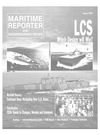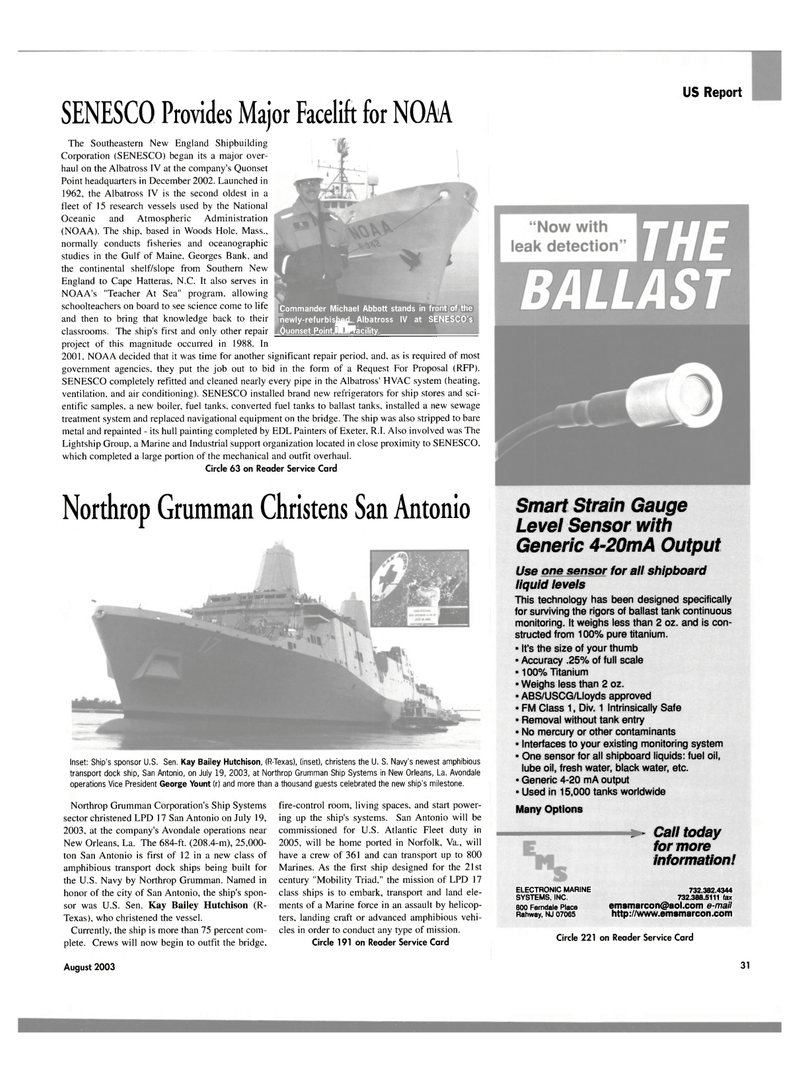
Page 31: of Maritime Reporter Magazine (August 2003)
Read this page in Pdf, Flash or Html5 edition of August 2003 Maritime Reporter Magazine
US Report SENESCO Provides Major Facelift for NOAA
The Southeastern New England Shipbuilding
Corporation (SENESCO) began its a major over- haul on the Albatross IV at the company's Quonset
Point headquarters in December 2002. Launched in 1962, the Albatross IV is the second oldest in a fleet of 15 research vessels used by the National
Oceanic and Atmospheric Administration (NOAA). The ship, based in Woods Hole. Mass., normally conducts fisheries and oceanographic studies in the Gulf of Maine. Georges Bank, and the continental shelf/slope from Southern New
England to Cape Hatteras, N.C. It also serves in
NOAA's "Teacher At Sea" program, allowing schoolteachers on board to see science come to life and then to bring that knowledge back to their classrooms. The ship's first and only other repair project of this magnitude occurred in 1988. In 2001, NOAA decided that it was time for another significant repair period, and. as is required of most government agencies, they put the job out to bid in the form of a Request For Proposal (RFP).
SENESCO completely refitted and cleaned nearly every pipe in the Albatross' HVAC system (heating, ventilation, and air conditioning). SENESCO installed brand new refrigerators for ship stores and sci- entific samples, a new boiler, fuel tanks, converted fuel tanks to ballast tanks, installed a new sewage treatment system and replaced navigational equipment on the bridge. The ship was also stripped to bare metal and repainted - its hull painting completed by EDL Painters of Exeter, R.I. Also involved was The
Lightship Group, a Marine and Industrial support organization located in close proximity to SENESCO. which completed a large portion of the mechanical and outfit overhaul.
Circle 63 on Reader Service Card
Commander Michael Abbott stands in front of the newly-refurbisj^L Albatross IV at SENESCO's
Quonset Point, R.Wacility.
Smart Strain Gauge
Level Sensor with
Generic 4-20mA Output
Use one sensor for all shipboard liquid levels
This technology has been designed specifically for surviving the rigors of ballast tank continuous monitoring. It weighs less than 2 oz. and is con- structed from 100% pure titanium. • It's the size of your thumb • Accuracy .25% of full scale • 100% Titanium • Weighs less than 2 oz. • ABS/USCG/Lloyds approved • FM Class 1, Div. 1 Intrinsically Safe • Removal without tank entry • No mercury or other contaminants • Interfaces to your existing monitoring system • One sensor for all shipboard liquids: fuel oil, lube oil, fresh water, black water, etc. • Generic 4-20 mA output • Used in 15,000 tanks worldwide
Many Options • Call today for more information!
ELECTRONIC MARINE
SYSTEMS, INC. 800 Ferndale Place
Rahway, NJ 07065
Circle 221 732.382.4344 732.388.5111 fax [email protected] e-mail http ://www.emsmarcon .com on Reader Service Card
Northrop Grumman Christens San Antonio
Inset: Ship's sponsor U.S. Sen. Kay Bailey Hutchison, (R-Texas), (inset), christens the U. S. Navy's newest amphibious transport dock ship, San Antonio, on July 19, 2003, at Northrop Grumman Ship Systems in New Orleans, La. Avondale operations Vice President George Yount (r) and more than a thousand guests celebrated the new ship's milestone.
Northrop Grumman Corporation's Ship Systems sector christened LPD 17 San Antonio on July 19, 2003, at the company's Avondale operations near
New Orleans, La. The 684-ft. (208.4-m), 25,000- ton San Antonio is first of 12 in a new class of amphibious transport dock ships being built for the U.S. Navy by Northrop Grumman. Named in honor of the city of San Antonio, the ship's spon- sor was U.S. Sen. Kay Bailey Hutchison (R-
Texas), who christened the vessel.
Currently, the ship is more than 75 percent com- plete. Crews will now begin to outfit the bridge. fire-control room, living spaces, and start power- ing up the ship's systems. San Antonio will be commissioned for U.S. Atlantic Fleet duty in 2005, will be home ported in Norfolk, Va., will have a crew of 361 and can transport up to 800
Marines. As the first ship designed for the 21st century "Mobility Triad." the mission of LPD 17 class ships is to embark, transport and land ele- ments of a Marine force in an assault by helicop- ters, landing craft or advanced amphibious vehi- cles in order to conduct any type of mission.
Circle 191 on Reader Service Card
August 2003 31

 30
30

 32
32
